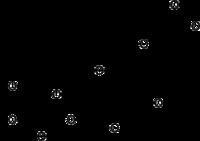Formula C29H42O11 | Molar mass 566.64 g/mol | |
 | ||
How to pronounce antiarin
Antiarins are cardiac glycoside poisons produced by the upas tree (Antiaris toxicaria). There are two forms, α-antiarin and β-antiarin.
Contents
- How to pronounce antiarin
- Beta antiarin
- Symptoms of Beta Antiarin Poisoning
- Toxicity LD50 of Beta Antiarin
- Physiological Systems AffectedMedical Properties
- References
Beta-antiarin
Beta-antiarin, a cardiac glycoside steroid, can be isolated from upas tree latex (Antiaris toxicaria). Its usage ranges from medical use, such as hypertension treatment, to arrow poison application. It also proves to be more poisonous than curare, sporting a high LD50 of 0.1 mg per kg in most mammals.
To date, beta-antiarin has only been isolated from the upas tree by the scientist H. Kiliani in 1896; no synthetic synthesis has yet been achieved.
Other names β-antiarin, antiarigenin-rhamnosideSymptoms of Beta-Antiarin Poisoning
Beta-antiarin poisoning, when observed in animals such as frogs and small mammals, visible symptoms include muscle spasms—particularly of the head and neck— and excess defecation. Paralysis can also be presented before death. The primary physiological system affected is the cardiac muscle, though gastro-intestinal tissue has also been known to be severely affected by this type of poisoning. Convulsions and spasms are not immediate, especially when the chemical is too diluted in water. In animal tests, time of death resulted anywhere from 5-30 minutes after administration. When used as an arrow poison, beta-antiarin produces twitches in the target, which then become full convulsions, unconsciousness, and final death through cardiac arrest.
Toxicity (LD50) of Beta-Antiarin
During tests performed on frogs and mammals, it was found that the minimum lethal dose for an amphibian was 1/300th mg. For a 300-400 g guinea pig, this lethal dose increased to 0.75 mg. Lethal dose for felines is 0.094 mg/kg, using intravenous injection. Meanwhile, 1 mg will kill a dog.
Physiological Systems Affected/Medical Properties
Beta-antiarin is administered to the body through injection. Once inside the body, the chemical will affect muscular and cardiac tissues. A heart attack occurs because beta-antiarin affects Na+K+-ATPase cardiac-muscle membrane activity.
However, the very effect that allows beta-antiarin to be a poison also gives it medicinal properties. It limits the sodium ion (Na+) concentration by blocking the Na+ pump, which then promotes calcium ions (Ca2+) to increase in concentration in the extracellular cardiac muscle domain, therein permitting the heart to contract. The mechanism through which sodium and calcium ions are exchanged, known as the sodium-calcium exchanger, allows for the exchange of ions to occur at a rate of 3:1 respectively. The cardiac cell exhibits a positive potential during ventricular systole, becomes depolarized, and permits calcium ions to rush in by the sodium-calcium exchanger. From here, the contraction occurs when the calcium ions leave and the cell re-polarizes. If the dosage of cardiac glycoside (i.e. beta-antiarin) doubles, then the substance becomes a poison.
